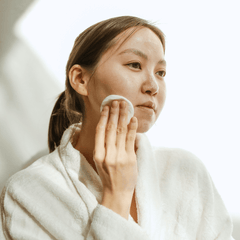How to Choose a Hormone-Safe Sunscreen

After a long winter, healthy sun exposure not only feels great, but is an important activity. It boosts vitamin D, increasing serotonin and helping your body absorb certain minerals, like calcium and magnesium. However, extended sun exposure comes with major risks, like sunburns, premature aging, and, worst of all, cancer. At this point, it may be obvious that applying sunscreen is critical to avoid the damaging rays of the sun. What’s less obvious is the fact that not all sunscreens are created equal. When it comes to hormone balance, some are much safer than others.
WHAT ARE ENDOCRINE-DISRUPTING CHEMICALS?
Whatever you put on your skin is absorbed into your bloodstream, that includes any ingredients found in your sunscreen. Unfortunately, many of the ingredients found in a lot of sunscreens are known to be endocrine-disrupting chemicals (EDCs).
One common type of EDC is xenoestrogens, which specifically mimic estrogen in the body. These compounds can overstimulate estrogen receptors or block natural estrogen activity, potentially contributing to hormonal acne, irregular cycles, and other hormone-related symptoms. Xenoestrogens are commonly found in plastics (like BPA), pesticides, and certain personal care products—including some chemical sunscreens.
To ensure your sun protection supports your skin without disrupting your hormones, here are some general guidelines for choosing a safer sunscreen.
IS IT BETTER TO USE MINERAL OR CHEMICAL SUNSCREENS?
MINERAL SUNSCREENS
There are two main types of sunscreens. Mineral (also known as physical) sunscreens are those whose active ingredients are minerals - zinc oxide and/or titanium dioxide. These ingredients sit on top of the skin like a mask and deflect harmful UV rays. This includes both UVB rays (the ones associated with skin burning) and UVA rays (the ones associated with skin aging). Since they don’t penetrate the skin, they also tend to be better for sensitive or reactive skin.
CHEMICAL SUNSCREENS
Chemical sunscreens, on the other hand, sink into the skin and work by absorbing UV rays. While they arguably blend better and last longer, they’re often formulated with harmful EDCs that mess with your hormones and lead to issues like imbalances. In addition, these EDCs end up in rivers, lakes, and oceans, damaging aquatic ecosystems.
AVOIDING ENDOCRINE DISRUPTORS
The following ingredients, commonly found in chemical sunscreens, have high harm potential, according to the Environmental Working Group (a reputable, not-for-profit research organization focused on identifying harmful chemicals in consumer products).
- Oxybenzone
- Octinoxate (Octyl methoxycinnamate)
- Homosalate
- Octisalate
- Octocrylene
- Avobenzone
In fact, in 2021, the Food and Drug Administration, which governs sunscreen safety in the US, found that only zinc oxide and titanium dioxide (the active ingredients in mineral sunscreens), could be classified as safe and effective.
One of the main reasons people tend to avoid mineral sunscreens is that they can leave a white cast on the skin. They’re also believed to be shinier and stickier than their chemical counterparts. That said, mineral sunscreens are rapidly evolving and there are now plenty of sheer and tinted options that blend seamlessly into the skin, ensuring you’re not left with a ghostly appearance or uncomfortable residue.
Another reason is that they are less water-resistant than chemical sunscreens and may require more frequent application if you’re swimming or sweating. However, since any sunscreen should be reapplied every 2 hours anyway, there's not much gained from using chemical sunscreens for a longer-lasting effect.
Choosing an EDC-free sunscreen that offers sufficient protection is much easier than you’d think. These days, there are loads of options, so when shopping around simply do your best to follow these rules and be sure to avoid the harmful chemical sunscreen ingredients listed above.
GUIDELINES FOR CHOOSING A HORMONE-SAFE SUNSCREEN
CHOOSE MINERAL
Ultimately, when it comes to selecting a hormone-safe sunscreen, it’s best to opt for mineral ones.
- Their active ingredients (zinc oxide and/or titanium dioxide) are not considered EDCs, and they typically contain less EDCs overall, compared to chemical options.
- They don’t get absorbed into the skin in the same way chemical sunscreens do.
- Zinc oxide and titanium dioxide protect from both UVB and UVA rays.
- They tend to be better for sensitive or reactive skin.
- They tend to be better for the environment.
It’s important to note that even if the active ingredients are mineral, you should still check that the rest of the formula isn’t loaded with other EDCs, like parabens, phthalates, and synthetic fragrances.
CHOOSE SPF 30 OR HIGHER
SPF stands for sun protection factor, a relative measurement of the amount of time the sunscreen will protect you from UVB rays. To get a general sense of how long a certain SPF will protect you from a sunburn, you can multiply the SPF value by the number of minutes it typically takes you to burn when exposed to the sun. So, for example, if you typically burn after 10 minutes of sun exposure, in theory SPF 30 would protect you for 300 minutes (5 hours). That said, there are some other variables that can impact this estimate, like how much you apply, your skin type, and the time of day.
Dermatologists recommend using SPF 30 or higher, but they also recommend re-applying any sunscreen, even water-resistant, every 2 hours or immediately after swimming or excessive sweating. So, while SPF 30 or higher is a good rule of thumb, as long as you’re re-applying as recommended, the level of SPF isn’t quite as important as some other sunscreen properties.
It’s also worth noting that higher SPF sunscreens typically have more endocrine-disrupting chemicals than lower ones, so opting for higher SPF is even more reason to be sure you’re checking ingredient labels.
CHOOSE BROAD-SPECTRUM
SPF only indicates protection against UVB rays, but UVA rays can also be harmful. Recent studies have shown that UVA rays can damage skin cells in the deepest layer of the epidermis. In many cases, even sunscreens with the highest SPF don’t shield against UVA rays, because they’re not broad-spectrum. Broad-spectrum sunscreens protect you from both UVA and UVB rays. Both zinc oxide and titanium dioxide protect from UVA and UVB rays, meaning that any mineral sunscreen you find will be naturally broad-spectrum. If you choose to opt for a chemical sunscreen, always be sure to select a broad-spectrum variant.
CHOOSE WATER-RESISTANT IF SWIMMING OR SWEATING
All sunscreens do eventually wash off when in water, so while there are no waterproof sunscreens, there are water-resistant ones and they are a must when swimming or sweating. The SPF in water-resistant sunscreens is maintained for about 40 minutes while swimming or sweating, so should be reapplied accordingly.
INFORMED SUNSCREEN CHOICES FOR HORMONE BALANCE
Like applying your skincare or taking your supplements, putting on sunscreen should be an integral part of your daily self-care ritual, especially in these summer months. And if you’re struggling with your hormonal health, choosing skincare, supplements, and sunscreen that work with your body, not against it, is another step in the direction of happy, balanced hormones.
Now, to be clear, this isn’t a free pass for skipping sunscreen if what’s available to you contains certain chemicals. It’s better to wear those sunscreens than expose yourself to irreversible skin damage. We’re here to educate you on the advantages and disadvantages of the options that exist, so that you can make the best hormone-balancing decision in any given situation. Sometimes, that means making do with whatever’s in front of you and that’s okay.
If you’re unsure whether the sunscreen you have contains EDCs, the Environmental Working Group’s Sunscreen Guide is a great resource. They rate sunscreens based on their ingredients, using a scale of 1-10, with 1 indicating lowest hazard, and 10 indicating highest. In fact, they rate all kinds of other skincare and personal care products too. Searching for specific products gives you more info about the toxicity of its ingredients, along with the overall EWG score. When it comes to balancing hormones, it’s best to stick to products with a rating or 1 or 2.
Of course, sunscreen is just one piece of the puzzle. If you’re looking for natural, hormone-friendly skincare, check out this guide to natural topical ingredients for acne to support your skin without unwanted chemicals.





